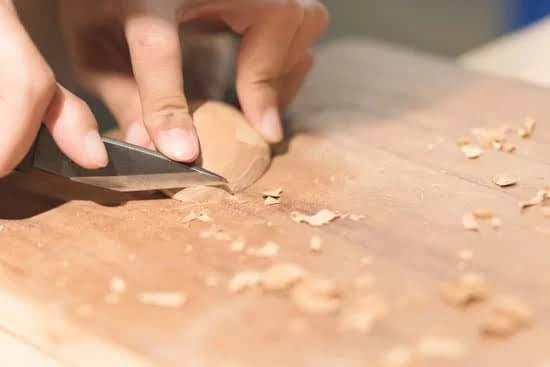Woodworking is a timeless craft that allows individuals to create beautiful and functional pieces using their hands, creativity, and precision. Learning how to do woodworking can be a fulfilling and rewarding experience for both beginners and seasoned artisans alike.
In this article, we will explore the value of woodworking as a skill, how to get started with the essential tools and materials, understanding different types of wood, implementing proper safety measures, mastering basic techniques, advancing to more intricate skills like wood carving and finishing, troubleshooting common mistakes, setting up a workshop, and finding inspiration within the woodworking community.
Mastering the art of woodworking offers numerous benefits beyond just creating stunning pieces. It provides an opportunity for individuals to hone their problem-solving skills, enhance their attention to detail, and unleash their creativity by turning raw materials into works of art. Whether you are interested in building furniture, crafting decorations, or simply enjoying the meditative process of working with wood, learning woodworking can be a valuable addition to your skill set.
Regardless of your level of expertise or experience in woodworking, there is always something new to learn and explore in this versatile craft. From understanding the unique characteristics of different types of wood to perfecting intricate joinery techniques or experimenting with various finishing methods, the possibilities are endless.
By following this guide and immersing yourself in the world of woodworking, you can embark on a journey of growth and self-discovery while creating masterful pieces that showcase your passion for craftsmanship.
Getting Started
Woodworking is a rewarding and fulfilling hobby that allows individuals to create beautiful and functional pieces of art with their own hands. However, before diving into this craft, it is essential to have the right tools and materials to ensure success in your projects. Here is a list of essential tools and materials needed to get started on your woodworking journey:
- Measuring tools: A tape measure, combination square, and ruler are crucial for accurate measurements in woodworking projects.
- Cutting tools: A good quality handsaw or circular saw for cutting wood, along with chisels and a sharp utility knife for detail work.
- Joinery tools: Clamps, hammers, screwdrivers, and a drill/driver set are necessary for joining wood pieces together securely.
- Sanding tools: Sandpaper in various grits, sanding blocks, and a power sander for smoothing out rough edges and surfaces.
Understanding the different types of wood available is also essential when starting out in woodworking. Different types of wood have varying characteristics that affect how they can be worked with and their overall appearance. Some common types of wood used in woodworking include:
- Pine: A softwood that is easy to work with, ideal for beginners due to its affordability.
- Oak: A hardwood known for its strength and durability, commonly used in furniture making.
- Maple: Another hardwood with a light color and fine grain pattern, often used for cabinets and cutting boards.
By familiarizing yourself with these essential tools, materials, and types of wood early on in your woodworking journey, you will be better equipped to tackle beginner projects confidently. Remember that practice makes perfect – don’t be afraid to make mistakes and learn from them as you grow your skills in woodworking. With dedication and patience, anyone can learn how to do woodworking effectively.
Understanding Wood
Woodworking involves working with different types of wood, each having its unique characteristics and uses. Understanding the properties of various woods is crucial in determining the suitability of a particular type for a project. Some popular types of wood used in woodworking include pine, oak, maple, cherry, and walnut. Each type varies in hardness, grain pattern, color, and workability.
One key aspect of learning how to do woodworking is familiarizing oneself with the different types of wood and their specific applications. For example, pine is often preferred for beginner projects due to its affordability and ease of manipulation.
On the other hand, hardwoods like oak and maple are commonly used for furniture making due to their durability and attractive finishes. Additionally, knowing how different woods respond to cutting, sanding, and finishing will guide you in selecting the most suitable material for your projects.
To deepen your understanding of the various types of wood available for woodworking, consider visiting lumber yards or woodworking supply stores. These establishments typically offer a wide selection of wood species along with information on their characteristics and recommended applications. Taking the time to handle different woods, observe their grain patterns, textures, and colors can greatly enhance your knowledge and skill in selecting the right material for your woodworking projects.
| Types of Wood | Properties |
|---|---|
| Pine | Affordable, easy to manipulate |
| Oak | Durable, attractive finishes |
| Maple | Durable with various finishing options |
Safety First
Woodworking can be a rewarding and enjoyable hobby, but it is essential to prioritize safety when working with tools and materials. Failure to adhere to proper safety measures can result in serious injury. Here are some key safety tips for beginners learning how to do woodworking:
- Wear appropriate safety gear such as safety goggles, ear protection, and a dust mask to protect your eyes, ears, and lungs from potential hazards.
- Make sure your workspace is well-ventilated to prevent the buildup of sawdust and fumes from finishes or adhesives.
- Keep your work area clean and organized to avoid trips, falls, or accidents caused by clutter.
Understanding the importance of proper safety measures is crucial before diving into woodworking projects. Additionally, having the right equipment can further enhance your safety while working with wood.
- Invest in quality tools that are well-maintained and sharp to prevent accidents caused by dull blades or worn-out equipment.
- Use clamps or other securing devices when cutting or sanding wood to prevent pieces from moving unexpectedly.
- Familiarize yourself with each tool’s specific safety guidelines and instructions before using them for any project.
By following these safety tips and having the necessary equipment in place, beginners can create a safe environment for learning how to do woodworking effectively. Prioritizing safety will not only protect you from harm but also ensure a more enjoyable woodworking experience as you hone your skills.
Basic Woodworking Techniques
Woodworking is a rewarding and practical skill to learn, allowing individuals to create beautiful and functional pieces from scratch. Learning how to do woodworking can be a fulfilling hobby or even a potential career path for those passionate about working with their hands and crafting with wood. This section will delve into the basic woodworking techniques that beginners should focus on, from accurate measuring to precise cutting and essential joinery methods.
One of the fundamental skills in woodworking is accurate measuring. Understanding how to use measuring tools such as tape measures, rulers, or combination squares is crucial for ensuring that your woodworking projects are precise and well-constructed. Taking the time to measure correctly before making cuts or assembling pieces can significantly impact the overall quality of your work.
Once you have mastered the art of measuring accurately, learning proper cutting techniques is essential in woodworking. Whether you are using a handsaw, circular saw, jigsaw, or table saw, understanding how to make clean and straight cuts is key to achieving professional-looking results in your projects. Additionally, practicing different cutting angles and styles will enhance your woodworking skills and broaden your capabilities in working with wood.
| Woodworking Skill | Description |
|---|---|
| Accurate Measuring | Using measuring tools effectively for precise dimensions. |
| Cutting Techniques | Mastery of various cutting tools for clean and straight cuts. |
Building Your Skills
Woodworking is a versatile and rewarding skill to learn, allowing individuals to create beautiful and functional pieces from scratch. As a beginner, the key to mastering woodworking lies in practice projects and utilizing available resources effectively. Learning how to do woodworking involves starting with simple projects that gradually increase in complexity as you build your skills. Here are some essential tips for beginners looking to enhance their woodworking abilities.
Practice Makes Perfect
One of the best ways to improve your woodworking skills is by engaging in regular practice projects. These projects can range from building basic shelves or benches to more intricate creations like tables or cabinets. By working on these hands-on activities, you will not only hone your technical skills but also gain confidence in handling different tools and materials. Remember, the more you practice, the better you will become at woodworking.
Utilize Online Resources
In today’s digital age, there is an abundance of online resources available to help beginners learn how to do woodworking effectively. From instructional videos on YouTube to dedicated websites offering step-by-step guides, there is no shortage of information at your fingertips. Additionally, joining online forums or social media groups dedicated to woodworking can provide valuable insights and tips from experienced craftsmen. Take advantage of these resources to expand your knowledge and refine your techniques.
Seek Mentorship
Another valuable way to advance your woodworking skills is by seeking mentorship from experienced woodworkers. Whether through formal classes or informal workshops, learning directly from seasoned professionals can offer invaluable guidance and personalized feedback on your work. Don’t be afraid to ask questions, seek advice, and observe how experts approach different projects. By engaging with mentors in the field, you can fast-track your learning process and develop a deeper understanding of woodworking principles.
By incorporating these strategies into your learning journey, you can steadily build your skills as a woodworker and tackle more challenging projects with confidence. Remember that patience and persistence are key when mastering this craft, so embrace every opportunity to learn and grow in your woodworking pursuits.
Advanced Techniques
Woodworking is a craft that offers endless opportunities for growth and learning, especially when delving into advanced techniques such as wood carving, turning, and finishing. These skills can elevate your woodworking projects to new levels of creativity and craftsmanship. Whether you are looking to add intricate designs to your work through carving, create unique shapes with turning, or achieve a professional finish, mastering these advanced techniques is a rewarding endeavor.
Wood carving involves the intricate art of shaping wood through the use of chisels, gouges, and knives. Learning how to carve requires patience, precision, and a keen eye for details. By starting with simple projects like relief carving or chip carving, beginners can gradually build their skills and confidence in this specialized aspect of woodworking. There are various resources available, from instructional books and videos to hands-on workshops, that can help aspiring wood carvers hone their craft.
Turning is another advanced technique in woodworking that involves using a lathe to shape wood into cylindrical forms such as bowls, spindles, and furniture legs. This method requires an understanding of both the tools used (such as gouges and chisels) and the characteristics of different types of wood.
By practicing on basic turning projects like pens or small bowls, woodworkers can familiarize themselves with the techniques involved in creating smooth curves and intricate details. As they progress, they can experiment with more complex designs and embellishments.
Finishing is an essential part of any woodworking project as it not only enhances the appearance of the piece but also protects it from wear and tear. From staining and varnishing to sanding and polishing, there are various finishing techniques that can add depth and luster to your work.
Understanding how different finishes interact with different types of wood is crucial in achieving professional results. By experimenting with samples on scrap pieces of wood and seeking advice from experienced woodworkers, beginners can develop their own finishing preferences and techniques tailored to their projects.
Troubleshooting Common Woodworking Mistakes and How to Fix Them
Woodworking, like any skill, requires practice and patience to master. Along the way, beginners are bound to encounter some common mistakes that can be frustrating. However, learning how to troubleshoot these issues is a crucial part of the learning process. By understanding how to identify and fix these mistakes, woodworkers can improve their skills and confidence in handling various woodworking projects.
Incorrect Measurements and Cuts
One of the most common mistakes in woodworking is making incorrect measurements or cuts. This can result in pieces that don’t fit together properly or uneven joints. To avoid this issue, it’s essential to double-check all measurements before cutting any wood.
Using precision tools like a combination square or a measuring tape with clear markings can help ensure accuracy. If a mistake does occur, don’t panic. One solution is to trim the piece slightly to adjust for the error or use fillers to make up for gaps in joints.
Splintering or Tear-Out
Splintering or tear-out often happens when cutting across the grain of wood or using dull blades on your tools. To prevent splintering, make sure to always cut with the grain whenever possible. Additionally, keeping your tools well-sharpened will result in cleaner cuts and minimize tear-out.
If splintering does occur during a cut, you can use masking tape on both sides of the cut line before sawing through it. This technique helps reduce splintering by providing support for the wood fibers as the blade passes through.
Gaps in Joints
Another common woodworking mistake is having gaps in joints when assembling pieces together. This issue can arise from inaccurate cutting, improperly sized dowels or tenons, or not using enough glue during assembly. To address this problem, start by ensuring that all pieces are accurately cut and properly aligned before gluing them together.
Consider using clamps to hold pieces firmly during drying to minimize movement that may cause gaps in joints. Additionally, applying wood filler after sanding can help fill any small gaps and create a seamless finish on your project.
By familiarizing yourself with these common woodworking mistakes and learning how to troubleshoot them effectively, you’ll be better equipped to navigate challenges as you build your skills in woodworking. Remember that making mistakes is a natural part of the learning process and an opportunity for growth and improvement as a woodworker.
Building Your Workshop
Building a workshop for woodworking is a crucial step in your journey to mastering this craft. Having a dedicated space where you can work on your projects comfortably and efficiently will not only improve the quality of your work but also enhance your overall woodworking experience. When setting up your workshop, there are several key factors to consider to ensure that it is functional and organized.
The first important aspect to address when building your workshop is space. Depending on the size of your projects and the tools you plan to use, you will need enough room to move around freely and safely. Make sure that you have adequate lighting in your workspace to see clearly while working with wood. Natural light is ideal, but if that’s not possible, invest in good quality task lighting to illuminate your work area effectively.
In addition to space and lighting, organizing your tools and materials is essential for a productive workshop. Consider investing in storage solutions such as shelves, cabinets, pegboards, or tool chests to keep everything neat and easily accessible. Labeling storage containers or using color-coded systems can also help you quickly find what you need during a project.
By creating a well-organized workspace, you can streamline your workflow and focus more on honing your woodworking skills. Overall, taking the time to set up a functional and organized workshop will greatly enhance your woodworking experience and make it easier for you to learn how to do woodworking effectively.
Finding Inspiration
Woodworking is a timeless craft that offers endless opportunities for creativity and self-expression. Learning how to work with wood not only allows you to create beautiful and functional pieces but also provides a sense of accomplishment and satisfaction. By exploring the world of woodworking, you can tap into your inner craftsman and develop valuable skills that will last a lifetime.
Finding inspiration in woodworking communities and projects is essential for continued learning and growth in this craft. Connecting with like-minded individuals who share your passion for working with wood can provide valuable insights, tips, and encouragement as you progress in your woodworking journey. Joining local woodworking clubs, attending workshops, or even participating in online forums can help you expand your knowledge and skills.
Moreover, exploring different woodworking projects can challenge you to step out of your comfort zone and try new techniques. Whether it’s building a simple table or crafting an intricate wooden sculpture, each project offers the opportunity to learn something new and hone your woodworking skills. By pushing yourself to tackle more complex projects, you’ll continue to grow as a woodworker and discover the endless possibilities that this craft has to offer.
In conclusion, learning how to do woodworking is a rewarding experience that requires patience, practice, and dedication. By starting with the basics, understanding different types of wood, prioritizing safety measures, mastering essential techniques, and diving into advanced skills like wood carving or turning, you can build a strong foundation in woodworking.
Remember that building your skills takes time and effort but by finding inspiration in woodworking communities, embarking on creative projects, and seeking continuous learning opportunities, you’ll be on your way to becoming a skilled craftsman in no time.
Frequently Asked Questions
Can You Teach Yourself Woodworking?
Yes, it is definitely possible to teach yourself woodworking. There are numerous online resources, books, and video tutorials available that can guide you through the basics of woodworking techniques, tools, and safety precautions. Starting with simple projects and gradually advancing to more complex ones can help you develop your skills.
How Do I Get Into Woodworking With No Experience?
Getting into woodworking with no experience can seem daunting, but it is entirely feasible with the right approach. Begin by familiarizing yourself with basic tools such as a saw, hammer, measuring tape, and sandpaper. Consider taking a beginner’s woodworking class or workshop to learn fundamental skills and techniques. Practice patience and perseverance as you work on improving your craftsmanship.
How Do I Start Woodworking From Scratch?
Starting woodworking from scratch requires some initial planning and investment in essential tools and materials. Begin by setting up a workspace with sufficient lighting, ventilation, and organization for your projects. Acquire basic tools like a saw, chisel, drill, measuring tape, and sandpaper to start practicing different woodworking techniques.
Experimenting with small projects can help you build confidence and skills over time. Remember to prioritize safety by wearing appropriate protective gear while working with wood.

Hi everyone! I’m a woodworker and blogger, and this is my woodworking blog. In my blog, I share tips and tricks for woodworkers of all skill levels, as well as project ideas that you can try yourself.





